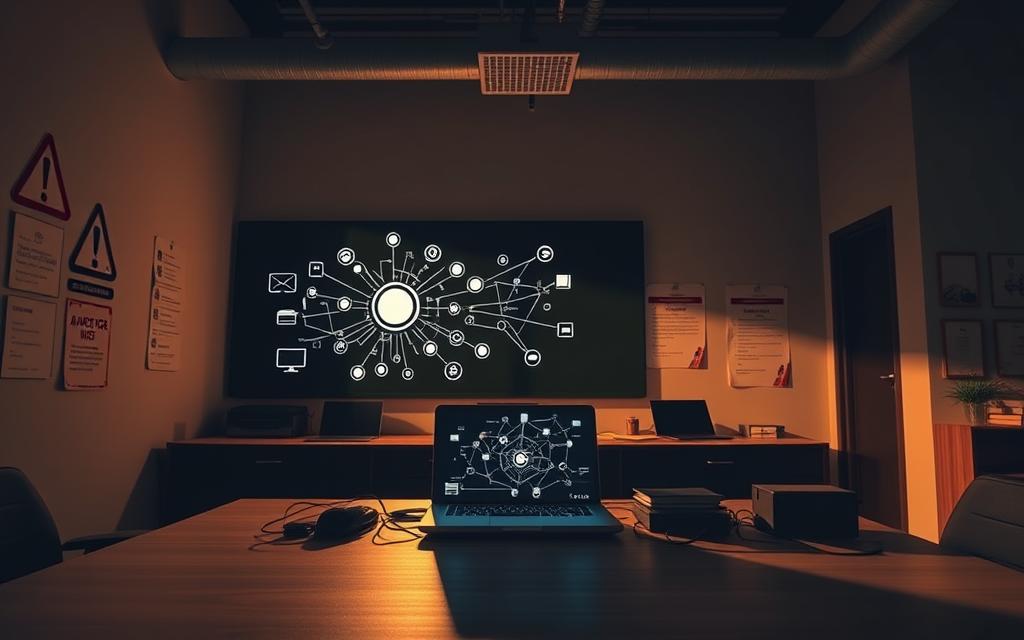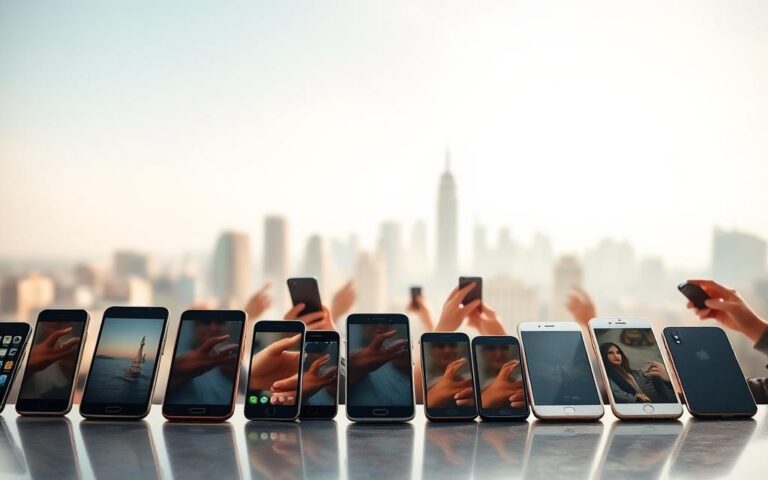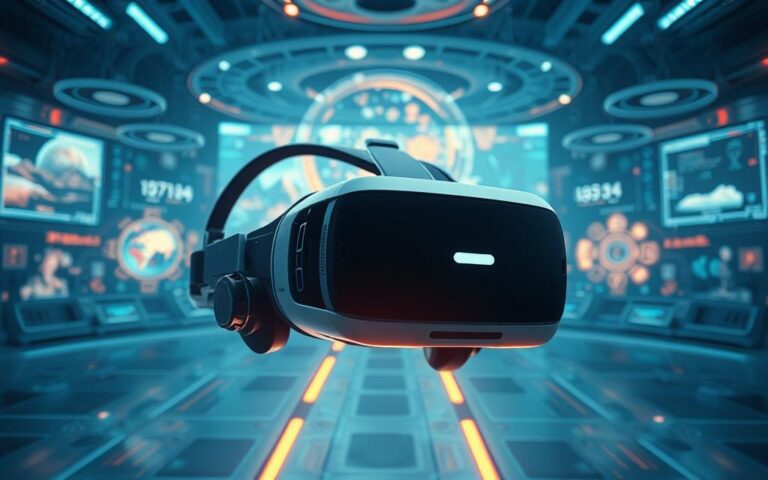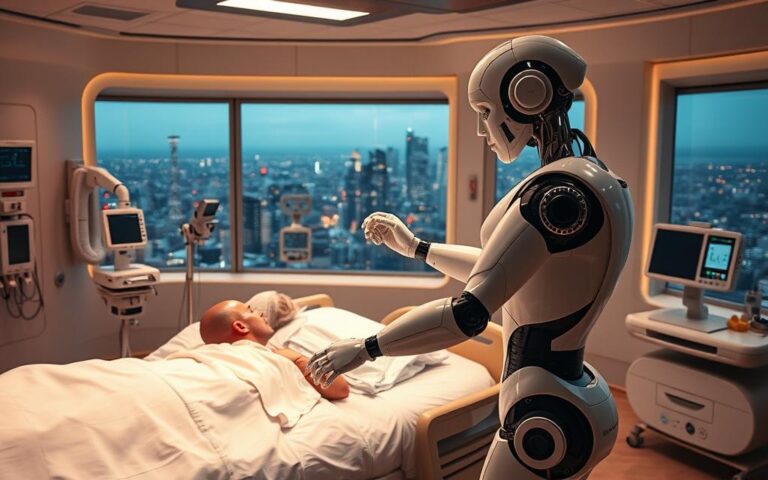Did you know by 2030, we’ll have about 29 billion IoT devices globally? These devices mark a big shift in American life. They cover everything from smarter homes to better healthcare. The journey started with a networked Coke machine in the 1980s. Now, IoT plays a huge role in our day-to-day life.
IoT technology is changing how we live, making things simpler, safer, and more efficient. A huge network of smart devices connects through the Internet. This lets them communicate and operate together smoothly. In this article, we’ll look at how IoT impacts American lives. We’ll see how it improves our comfort, safety, and helps the planet too.
What is IoT and Why It Matters
The concept of the Internet of Things (IoT) changes how we use technology every day. It links devices together, allowing them to talk and share data without needing us to do anything. This makes our day-to-day easier and more connected.
Definition of IoT
IoT includes many gadgets, like smart home devices, wearables, and industrial sensors. These devices have sensors that gather and send data online. They make our experiences better and let automation and smart living happen.
Importance of IoT in Daily Life
IoT is more than just handy. It helps us live smarter, improving areas like health, transport, and farming. With IoT, devices work together. This lets us make better choices, simplifies tasks, and saves resources. IoT makes life better by offering instant updates and automated solutions, leading us to a connected future.
Smart Home Devices: Making Life Easier
Smart home tech changes how Americans live. With IoT devices, people get more convenience, security, and save energy. We’ll look at three main smart home devices that boost ease and green living.
Smart Thermostats
Smart thermostats like the Nest adapt to your temperature likes. They adjust your home’s heat or cool automatically. This not only keeps you comfy but also cuts energy waste. By using less energy, families can save 10-15% on their bills each year.
Home Security Systems
Modern home security systems have grown smarter with technology. Gadgets like the Ring doorbell and Arlo cameras let you watch your home live on your phone. They have motion sensors, let you see remotely, and alert you to dangers. This keeps you up-to-date and your home safe.
Smart Lighting Solutions
Smart lights, such as Philips Hue and LIFX, let you change light settings from afar. You can set the mood for any event and save energy. Lights can shut off when you leave or dim as it gets bright outside. This makes your home nicer while using less energy.
Wearable Technology: Health at Your Fingertips
Wearable tech has changed how we handle our health. It offers gadgets that help users monitor their well-being closely. From tracking steps to checking heart rates, these tools are key in health management.
Fitness Trackers
Devices like the Fitbit count your steps, calories, and track sleep. They push people to reach their health goals. With real-time updates, making healthier choices becomes easier.
Smartwatches
Smartwatches blend classic watch looks with health tracking. The Apple Watch, for example, lets you see calls and track your heart. These gadgets keep your health details right on your wrist.
Health Monitoring Devices
Some devices focus on specific health needs, like smart pillboxes. They can send important health info to doctors. This helps patients get quick and accurate care based on their health data.
IoT in Transportation: A Safer Commute
The integration of IoT in transportation is changing the game. Cars and buses are now smarter and safer, making your commute smoother. With IoT, we see better vehicle safety, smarter traffic control, and new ways to share rides.
Connected Cars
Connected vehicles use new tech to make driving safer and better. They have sensors that know what’s happening around them. Companies like Ford and General Motors lead with tech like real-time car health updates, lane help, and emergency services. This tech gives drivers key info to avoid accidents.
Smart Traffic Management
Smart traffic systems use data to make traffic flow better and reduce jams. They link traffic lights with cars to adjust to what’s happening now. This makes roads safer and gets you to your destination faster. Cities are turning to IoT for smarter traffic solutions to make moving around easier.
Ride-Sharing Apps
Ride-sharing apps have changed city travel for the better. Apps like Uber and Lyft use IoT to connect drivers and passengers quickly. This makes better use of cars and cuts down on traffic. As IoT grows, ride-sharing will only get better and more efficient.
Agriculture: IoT for Sustainable Farming
The use of IoT in agriculture is changing sustainable farming. It lets farmers use high-tech tools for better farming. These tools help use resources well and make crops grow better.
Precision Farming Tools
Precision farming involves sensors and data analytics to check fields. These evaluate soil moisture and crop health. This lets farmers use water and fertilizer better.
By using these technologies, farmers get more crops and reduce harmful effects on the environment. This way, they help save resources and support sustainable farming.
Livestock Monitoring Systems
Keeping an eye on livestock health is key for a good farm. IoT devices with tracking make sure farmers know where their animals are and how they’re doing all the time. These systems warn farmers about any health or behavior changes. This lets them act fast to keep their herds well.
This new way of managing livestock leads to better farm productivity. It also makes farming more sustainable.
Retail Transformation: Enhancing Customer Experience
The retail world is changing quickly, thanks to IoT retail solutions. These advances are making shops run better and improving shopping for everyone. Shops are now using high-tech to organize their goods and offer unique shopping trips that meet each customer’s needs.
Smart Inventory Management
Smart inventory systems use real-time data to keep just the right amount of stock. This cuts down on waste and makes the supply chain more efficient. With these systems, shops can easily order more goods and keep track of stock in many locations. This means customers will find what they’re looking for every time, making their shopping experience better.
Personalized Shopping Experiences
Retailers create personalized shopping trips by analyzing what customers like and how they shop. By understanding customer data, shops can suggest products that each shopper might like. This personalized touch makes shopping more fun and relevant to each customer. It also keeps customers coming back, showing how powerful IoT can be in creating strong customer connections.
IoT in Healthcare: Revolutionizing Patient Care
The world of healthcare has changed a lot because of health tech. IoT healthcare solutions are helping a lot. They make healthcare better for doctors and patients. They make care better and help treat people better. Things like remote monitoring and smart devices are key. They keep an eye on health without needing to visit the hospital a lot.
Remote Patient Monitoring
Remote monitoring lets doctors check on patients easily. Patients wear smart devices that send health info in real time. This means doctors can quickly deal with health issues. It’s really helpful for people with chronic illnesses. They get the support they need without going to the clinic often.
Smart Medical Devices
Smart medical devices really change how we look after patients. For example, smart pills and connected syringes give useful info. This helps doctors stick to treatments better. With these tools, care can be customized for each person. These devices improve health outcomes and help patients talk better with their doctors.
| Device Type | Functionality | Benefits |
|---|---|---|
| Smart Pill | Tracks medication adherence | Improved patient compliance, reduces hospital readmissions |
| Connected Syringe | Monitors insulin administration | Enhanced accuracy, immediate feedback for adjustments |
| Wearable Monitor | Real-time heart rate & activity tracking | Encourages lifestyle changes, alerts for abnormal readings |
Environmental Impact: IoT for a Greener Planet
IoT technologies are key in making the environment better. With smart tools, we can handle waste and check air quality better. This leads to a healthier planet. Green technology helps save resources and fight pollution well.
Smart Waste Management
Smart waste systems use IoT to improve how we deal with trash, lessening harm to nature. Sensors in bins track how full they are, leading to smarter trash pickup. This cuts down on fuel use and pollution. Cities using this tech save money and recycle more.
Air Quality Monitoring
Air sensors are vital in monitoring pollution everywhere. They give data that helps make laws to clean the air. People get updates on pollution, helping them stay healthy. Using this tech makes everyone more eco-friendly, aiming for a better planet.
IoT and Education: A New Learning Experience
IoT education apps are changing old school classrooms into smart ones. These places are now full of life, thanks to educational tech. It boosts teamwork, imagination, and how well kids remember what they learn. Also, connected gadgets let students and teachers talk in real-time. This makes learning way more fun and interactive.
Smart Classrooms
The classrooms of the future are here with smart tech. Kids use interactive whiteboards, tablets, and projectors to learn in a new way. These tools help them work together easily. They also get instant feedback and use digital resources that fit their learning needs.
Virtual Reality Learning
Education is diving into virtual reality (VR) for a fresh learning style. VR lets students step into 3D worlds where they can live out history, science, or math lessons. It’s not just about knowing more; it’s about making learning an adventure everyone wants to go on.
| Technology | Benefits | Application in Education |
|---|---|---|
| Smart Classrooms | Enhances collaboration, increases engagement | Group projects, interactive lessons |
| Virtual Reality | Provides immersive learning experiences | Exploring history, science simulations |
| IoT Integration | Streamlined communication between devices | Accessing learning materials, remote assessments |
Challenges of Implementing IoT
The path to using the Internet of Things (IoT) is full of big hurdles for businesses. The advantages of IoT are vast, but overcoming its challenges is key for smooth adoption and better user experiences. Main issues include security and making IoT work with current systems.
Security Concerns
Security in IoT is a big worry since connected gadgets often attract cyberattacks. These weak spots may expose users’ data, endangering their privacy. Businesses need to take strong security steps to keep information safe and keep users’ trust. This means using end-to-end encryption, updating software often, and using strict access rules.
Integration with Existing Systems
Adding IoT systems to old ones is another big challenge. Merging new IoT tech with existing setups needs proper planning and money. Businesses should think about how new and old can work together without issues. They may need to check the current systems and see what changes are needed.
| Challenge | Description | Possible Solutions |
|---|---|---|
| IoT Security | Vulnerabilities in connected devices can lead to data breaches. | Implement strong encryption, regular updates, and access controls. |
| System Integration | Compatibility issues arise when merging new devices with legacy systems. | Evaluate current infrastructure and invest in necessary improvements. |
| Data Privacy | Users face risks related to unauthorized access to their personal information. | Establish strict data handling protocols and user consent mechanisms. |

The Future of IoT in American Life
IoT’s future looks promising with expected advancements. Predictions say we could see 29 billion connected devices by 2030. This reflects our growing need for tech that works together. It means IoT will play a bigger part in making tasks easier and our lives more convenient.
Predictions for IoT Growth
Experts believe new technologies will change IoT, making it smarter. With better AI and systems that work on their own, people will get new, easier solutions. These changes will make daily life smoother. They will also help us live in ways that are better for the planet by saving energy and using resources wisely.
Potential Innovations on the Horizon
The next wave of IoT innovations could change how we interact with the world. We might get smarter home systems, better health trackers, and cities that are nicer to live in. These advancements will make American life more efficient and user-friendly. The journey ahead with IoT is exciting.




